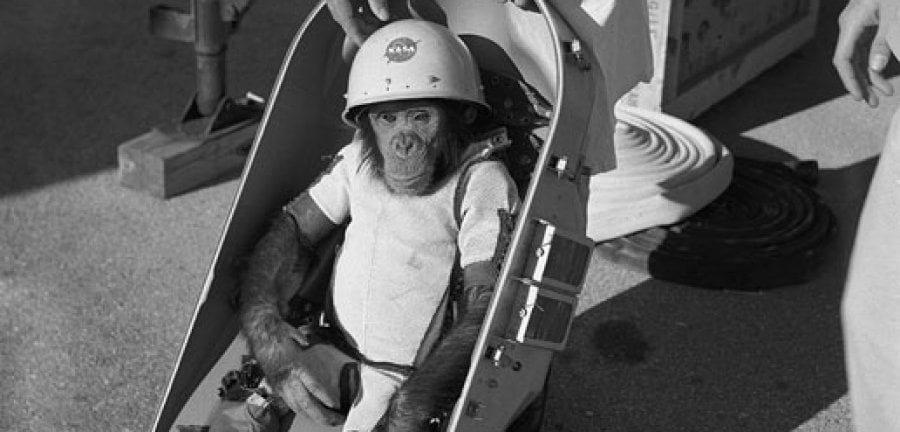Fifty years ago this week, a young chimpanzee was launched into space on a suborbital flight that lasted just a little over 16 minutes. Chimpanzee number 65 was chosen from a group 40 captive chimpanzee candidates for the mission—one that left him crammed into a space capsule that would partially depressurize during its short flight.
While his flight was declared a success by NASA, it was preceded by months of pain and followed by years of lonely isolation for the baby chimpanzee, who was given the name “Ham” (after the acronym of the Air Force medical facility where he was cruelly trained) after his return.
What very few people at the time knew was that Ham had been captured in the jungles of West Africa by animal trappers and torn away from his family at the age of 2. He was subjected to 18 months of “training” in which he received electrical shocks to the soles of his feet when he failed to respond correctly in tests and had restraints placed on his neck, torso, and limbs for extended periods.
After completing his space mission, Ham was sent to the National Zoo in Washington, D.C., where this highly intelligent and social animal lived in lonely isolation for 17 long years. He was then transferred to the North Carolina Zoo, where he died at the age of 26—roughly half the life expectancy of chimpanzees living free in the wild.
That was 50 years ago, and you would think that NASA would have advanced beyond the archaic and fundamentally flawed science of cruel and irrelevant experiments on animals in its quest for space travel. Think again.
As recently as a few months ago, NASA was moving full steam ahead with a plan to blast dozens of squirrel monkeys with harmful doses of radiation. Then they would be isolated in cages and subjected to years of behavioral experiments in order to measure the damage caused by the radiation, which often includes cancer, loss of motor control, brain damage, and early death. But thanks in large part to a slew of PETA protests as well as e-mails and phone calls from PETA supporters and some high-profile support-including former NASA astronaut Leroy Chiao as well as April Evans, a NASA aerospace engineer who quit her job over the proposed plan—NASA grounded its ill-conceived scheme.
Besides the cruelty inherent in animal experimentation—whether the excuse is to test a new perfume additive or to conquer outer space—it is also bad for humans. That’s because the often vast physiological and anatomical differences between humans and other animals renders the retrieved data dangerously unreliable.
You can mark the sad anniversary of Ham’s voyage into space and keep the pressure on those responsible for cruel animal experiments by pledging to be cruelty-free and getting active for animals who are suffering in laboratories.





